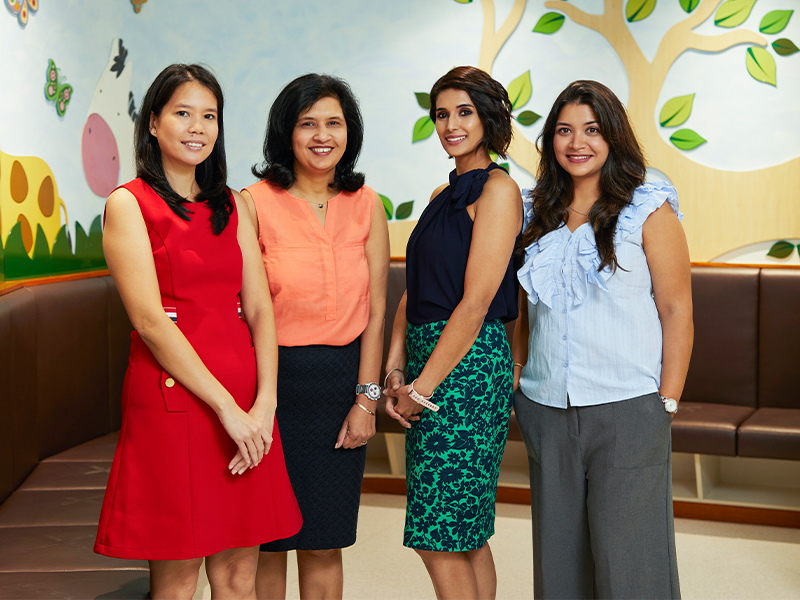From health screening tests to wellness checks, here are some of the reasons why it can be helpful to pay a visit to your GP or family doctor. Keep one step ahead by scheduling routine GP visits for your family – whether they’re babies, kids or teens. Here’s why well checks could make for a healthier 2024 for all.
Well checks for your kids and teens
Even if your child seems to be in perfect health, regular wellness checks can help maintain their optimal health, explains DR MEGHA JASM, a paediatrician at IMC Children’s. Each visit offers a chance to monitor your child’s growth. Your doctor will assess if they are meeting milestones for gross and fine motor skills, vision, hearing and social development.

For the smallest members of the family
Every parent who’s left hospital with a fresh newborn knows that babies need frequent well visits! These start one week after birth and tend to be scheduled around regular vaccinations, usually at one, two, four, six, nine, 12, 15 and 18 months, explains Dr Jasm.
At IMC Children’s, wellness check consultations include:
- physical examination by a paediatrician;
- identification and discussion of any new concerns;
- developmental assessment;
- growth screening including height, weight, head circumference and BMI measurement;
- discussion about your child’s diet, sleep, hygiene, behavioural patterns and bowel habits; and • referrals, if needed.
The visits are also a great opportunity to check for vaccine updates based on overseas schedules. “At IMC, we work with parents to customise children’s vaccinations to incorporate vaccines from parent countries to allow ease of travel and relocation,” says Dr Jasm. It’s also a time for parents to discuss any challenges, and get evidence-based advice on breastfeeding, weight gain, bowel movements, weaning and more.
For active toddlers and kids
Once your child hits the toddler years (from two), annual well checks are best, says Dr Jasm. The doctor will track the development and growth of your child (and as a parent you can raise any concerns) and they may identify conditions you might have missed – for example, congenital heart defects or eye problems that can go unnoticed. Early detection of a health problem leads to a quicker and more successful treatment.
At IMC, a standard children’s well consultation includes:
- discussion of any ongoing medical issues or allergies;
- discussion about your child’s routine including diet, sleeping and toilet training;
- discussion about their behaviour;
- developmental screening;
- physical examination;
- vision testing;
- growth screening including height, weight and BMI; and
- referrals, if necessary
Well checks are an opportunity to make sure your little one is up to date with immunisations. “Your child’s vaccination schedule will be tailored to ensure adequate coverage for Singapore and your home country,” says Dr Jasm. “We also provide information for upcoming travel, specifically extra vaccines required and travel kits containing commonly needed medications.”

For growing tweens and teens
The start of puberty is a crucial stage in a child’s development, according to DR SHIVANI PALIWAL, a paediatric-trained doctor at IMC Children’s. “Adolescents need additional focus and guidance, so a health screening at this age is essential”, she says. “Puberty is a stage of physical and mental changes that can affect emotional stability. With added influences of peer pressure, wellness checks are a great way to identify any stressors early, to best manage them.”
A teen health screening should include discussions about:
- medical history and vaccinations for meningitis, tetanus and HPV;
- puberty and body changes;
- physical activity and fitness regimes;
- nutrition and eating habits;
- home, education and academics;
- social life, social media use and coping mechanisms; and
- sexuality, drugs, alcohol and substance abuse, and an assessment of mental health (for older adolescents).
It’s helpful to have a caring doctor to guide you through your child’s ages and stages, and help them achieve optimal wellness!
International Medical Clinic
IMC Camden, IMC Children’s, IMC Jelita and IMC Katong
6733 4440 | imc-healthcare.com
Longevity screening for adults
Good long-term health is the key for ageing gracefully and enjoying a high quality of life, according to surgeon DR GERARD EE, the managing director at Clifford Clinic. The clinic specialises in dermatology, aesthetics and plastic surgery. Dr Ee believes in promoting the importance of longevity and providing access to quality health screening services.
“Under our Longevity Screening Program, we aim to provide patients with a comprehensive snapshot of their health, a look at their likelihood of developing certain conditions/diseases and detecting them if already developed. Our doctors also provide personalised medical advice on how patients can optimise their health and improve their longevity,” says Dr Ee.
The holistic wellness and longevity program includes:
- A lifestyle component – involving zone 2 exercise testing and stool microbiome analysis. A detailed sleep study looking into the amount of REM and deep sleep a patient is getting is also performed.
- A medical component – incorporating biological age testing, bone density scan, stress ECG, and blood analysis for general health and tumour markers. Multicancer Early Detection (MCED) testing is also done to detect the risk of early cancers before they appear.
Different genetic health screenings available and why they are helpful
Health screenings and wellness checks provide patients with vital information about their bodies needed to make informed medical and lifestyle choices. “Certain genes or changes in gene expression indicate the risk of developing health conditions like cancer or diabetes”, says Dr Ee. Testing positive for carrying a risk gene doesn’t mean you will develop the associated disease, but it can tell you how high your risk is to prompt you to seek treatment early or change your lifestyle, he explains.

#1 Genetic testing for risk of early cancers
Multicancer Early Detection (MCED) is a technique using a simple blood test to identify cancer in its early stages by detecting certain biomarkers in the blood. This is done by using advanced technology such as DNA sequencing. “MCED allows us to identify or predict cancer risks, even before they appear on our traditional health screening scans for tumour markers or imaging like X-rays, CT or MRI scans,” says Dr Ee.
#2 Health Screening
Traditional health screening programs are available at The Clifford Clinic as well. “These annual check-ups are important to ensure that your hormones and organs are in line with good health,” says Dr Ee. They’re also a great way to detect basic cardiac abnormalities, and provide a general screen for any health related issues that you may currently be facing, he explains.
To find out more about genetic testing and longevity screening, reach out to The Clifford Clinic for an appointment.
The Clifford Clinic
#01-01 Singapore Land Tower, 50 Raffles Place
6532 2400 | cliffordclinic.com
This article first appeared in the January 2024 edition of Expat Living. You can purchase the latest issue or subscribe, so you never miss a copy!




